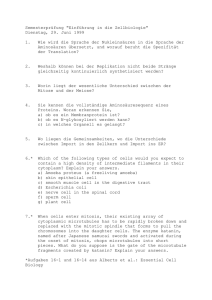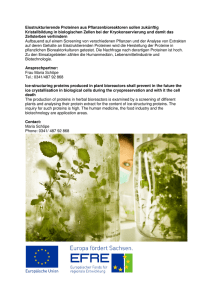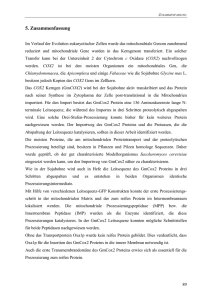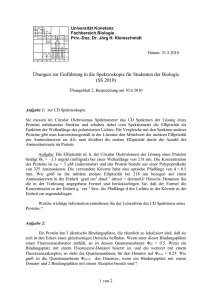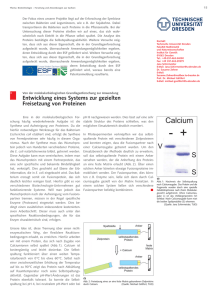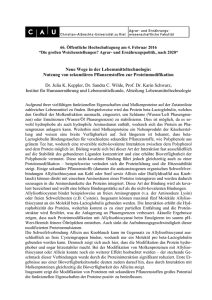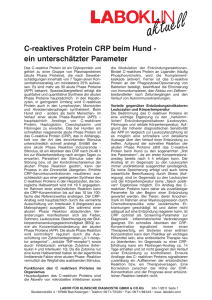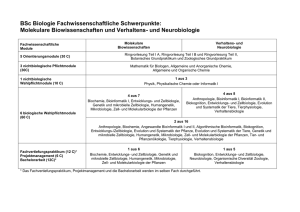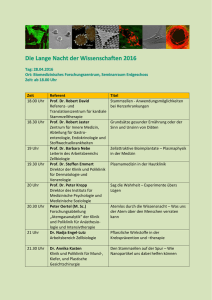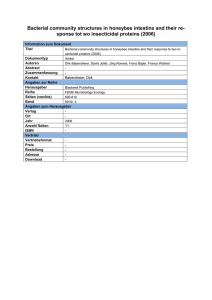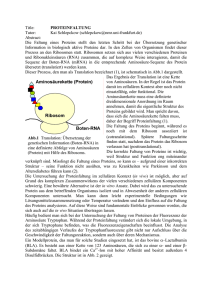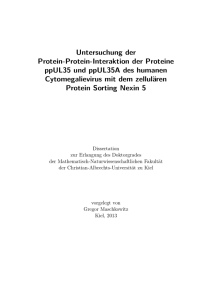Zellbiologie_Zusa
Werbung
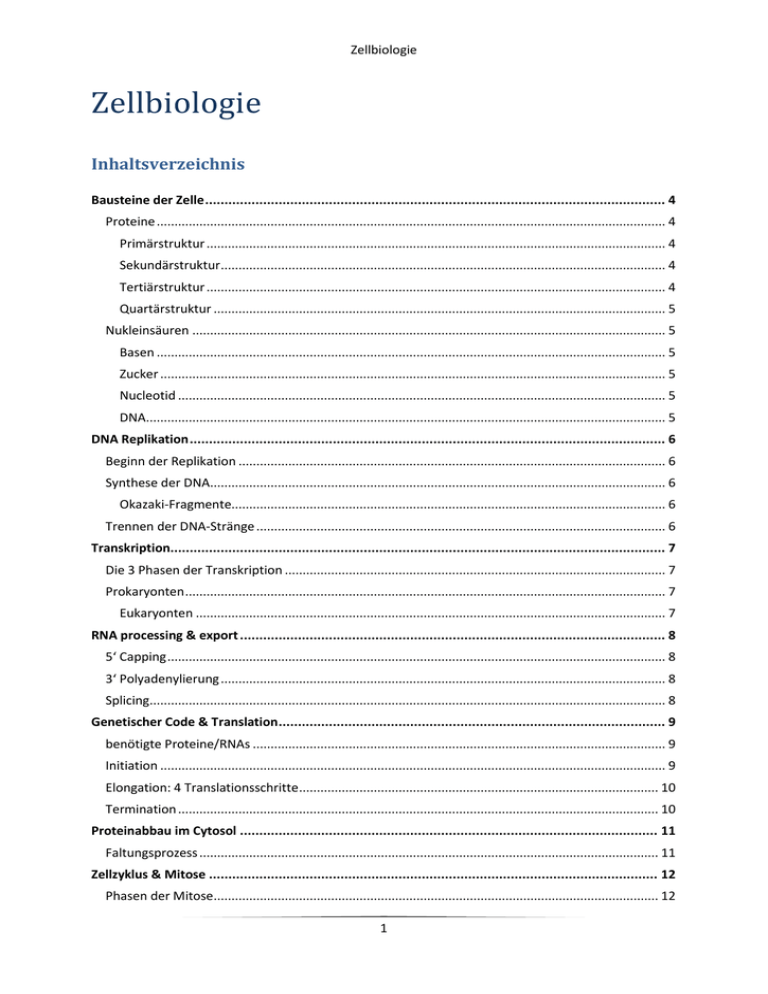
Zellbiologie Zellbiologie Inhaltsverzeichnis Bausteine der Zelle ....................................................................................................................... 4 Proteine ............................................................................................................................................... 4 Primärstruktur ................................................................................................................................. 4 Sekundärstruktur ............................................................................................................................. 4 Tertiärstruktur ................................................................................................................................. 4 Quartärstruktur ............................................................................................................................... 5 Nukleinsäuren ..................................................................................................................................... 5 Basen ............................................................................................................................................... 5 Zucker .............................................................................................................................................. 5 Nucleotid ......................................................................................................................................... 5 DNA.................................................................................................................................................. 5 DNA Replikation ........................................................................................................................... 6 Beginn der Replikation ........................................................................................................................ 6 Synthese der DNA................................................................................................................................ 6 Okazaki-Fragmente.......................................................................................................................... 6 Trennen der DNA-Stränge ................................................................................................................... 6 Transkription................................................................................................................................ 7 Die 3 Phasen der Transkription ........................................................................................................... 7 Prokaryonten ....................................................................................................................................... 7 Eukaryonten .................................................................................................................................... 7 RNA processing & export .............................................................................................................. 8 5‘ Capping ............................................................................................................................................ 8 3‘ Polyadenylierung ............................................................................................................................. 8 Splicing................................................................................................................................................. 8 Genetischer Code & Translation .................................................................................................... 9 benötigte Proteine/RNAs .................................................................................................................... 9 Initiation .............................................................................................................................................. 9 Elongation: 4 Translationsschritte ..................................................................................................... 10 Termination ....................................................................................................................................... 10 Proteinabbau im Cytosol ............................................................................................................ 11 Faltungsprozess ................................................................................................................................. 11 Zellzyklus & Mitose .................................................................................................................... 12 Phasen der Mitose............................................................................................................................. 12 1 Zellbiologie 1. Interphase ............................................................................................................................. 12 2. Prophase ................................................................................................................................ 12 3. Prometaphase ....................................................................................................................... 12 4. Metaphase............................................................................................................................. 12 5. Anaphase ............................................................................................................................... 12 6. Telophase .............................................................................................................................. 12 7. Cytokinese ............................................................................................................................. 12 Centrosomen ..................................................................................................................................... 12 Kinetochor ......................................................................................................................................... 13 Anaphase ....................................................................................................................................... 13 Cytokinese ......................................................................................................................................... 13 Kontrollsystem des Zellzyklus ............................................................................................................ 13 Structure, Function & Biogenesis of cellular Organelles ............................................................... 14 General Organisation ........................................................................................................................ 14 Origin of organelles ........................................................................................................................... 14 Plasma membrane: example of an organelle membrane ................................................................. 14 Sorting (how do proteins find their appropriate location)................................................................ 15 Endoplasmatic reticulum (ER) ........................................................................................................... 15 Golgi complex .................................................................................................................................... 16 Exocytosis .................................................................................................................................. 17 Transport-routes in the exocytic pathway ........................................................................................ 17 Exit from the ER ................................................................................................................................. 17 Protein-Foldung, Olgomerization & Transport-Competence ........................................................ 17 Retention of Proteins in the ER ..................................................................................................... 17 Biochemical approach in the intact cell (to study exocytosis) ...................................................... 17 Morphological approach ............................................................................................................... 17 Genetic approach .......................................................................................................................... 17 From the ER to the Golgi ................................................................................................................... 18 Budding.......................................................................................................................................... 18 Docking .......................................................................................................................................... 18 Fusion ............................................................................................................................................ 18 Snares ............................................................................................................................................ 18 Membrane transport in the early secretory pathway................................................................... 18 Protein sorting in the TGN (Trans-Golgi network) ............................................................................ 18 3 Transport routes from the Golgi (TGN) ...................................................................................... 18 Endocytosis ................................................................................................................................ 19 Structure of the endocytic Pathway .................................................................................................. 19 Coated Pits / Coated Vesicles ............................................................................................................ 19 2 Zellbiologie Coated Vesicles.............................................................................................................................. 19 Receptor-mediated Endocytosis & Cholesterole .............................................................................. 19 Endocytosis motives & receptor fates .............................................................................................. 20 Receptor fate ................................................................................................................................. 20 Endocytosis & virus infection ............................................................................................................ 20 Transcytosis ....................................................................................................................................... 21 Phagocytosis ...................................................................................................................................... 21 Cavolae .............................................................................................................................................. 21 Experiment: Caveolin-I knock out mice ......................................................................................... 21 Cytoskeleton .............................................................................................................................. 22 Microtubules (MT)............................................................................................................................. 22 Structure ........................................................................................................................................ 22 Movement of Cilia ......................................................................................................................... 22 Organelle Transport along MT ...................................................................................................... 22 Dynamic Instability ........................................................................................................................ 23 Cell control of MT .......................................................................................................................... 23 MT in cell division .......................................................................................................................... 23 Microfilaments .................................................................................................................................. 23 Actin, Myosin & muscle motion .................................................................................................... 23 Intermediate filaments .................................................................................................................. 24 Cell contacts, extracellular matrix & tissue organization .............................................................. 25 Cell contacts ...................................................................................................................................... 25 Tight junctions ............................................................................................................................... 25 Anchoring contacts ........................................................................................................................ 25 Gap junctions................................................................................................................................. 25 Extracellular matrix ........................................................................................................................... 25 Collagen ......................................................................................................................................... 26 Elastin ............................................................................................................................................ 26 Fibronectin .................................................................................................................................... 26 Glycosaminoglycans & Proteoclycans ........................................................................................... 27 Bridging the ECM and the cytoskeleton ........................................................................................ 27 Cell-Cell contact: main concepts ....................................................................................................... 27 extracellular matrix: important concepts.......................................................................................... 27 Tissues & Organes ............................................................................................................................. 27 3 Zellbiologie Bausteine der Zelle Übersicht Proteine (Enzyme, Strukturproteine…) o Untereinheit: Aminosäuren Nukleinsäuren (DNA, RNA) o Untereinheit: Nukleotide Membrane (Plasma, ER, Golgi, …) o Untereinheit: Lipide ( Fettsäuren) Polysaccharide o Untereinheit: Zucker Proteine Aminosäure: (kommt nur in L-Form vor, nicht D) Glutamic acid (Glu, E) fängt Ammoniak ab Essentielle AS: Ile, Leu, Lys, Met, Phe, Thr, Trp, Val (können wir nicht selbst produzieren) Fusion von Aminosäuren: Neue Aminosäure immer an C-Seite angehängt lineares Peptidrückgrad Primärstruktur nichtkovalente Bindungen zwischen Seitenketten ionische Wechselwirkungen Wasserstoffbrücken van der Waals hydrophobe Seitenketten werden im Inneren des Proteins versteckt Disulfidbrücken bei Cystein intermolekular intramolekular Sekundärstruktur α-Helix o Prolin: „helix breakers“ Ende der α-Helix β-Faltblatt o Wasserstoffbindungen Tertiärstruktur „funktionelle Domänen“ Mischung aus mehreren α und/oder β Strukturen könnte an sich alleine sein stabil 4 Zellbiologie Quartärstruktur mehrere identische oder unterschiedliche Tertiärstrukturen Spezifische Bindung eines Moleküls (Ligand) an ein Protein: Protein kann aufgrund Ligand Konformation ändern (z.B. GTPase) Nukleinsäuren Base + Zucker = Nukleosid Base + Zucker + Phosphat = Nukleotid Basen Zucker Nucleotid ATP: adenosine triphosphat ADP: adenosine diphosphat AMP: adenosie monophosphat analog bei anderen Basen adenosine: ribose + adenin Nukleosid DNA Wasserstoffbrücken zwischen Basenpaaren (AT: 2, GC: 3) kleine / grosse Furche bei Doppelhelix DNA ist um Nucleosomen (Histone) gewickelt muss zur Transkription gelockert werden Unterschiede von RNA Uracil statt Thymin OH-Zucker statt H einzelsträngig (meistens, Doppelstrang auch möglich) Intramolekulare Basenpaarung, Bsp: tRNA 5 Zellbiologie DNA Replikation zirkuläres Chromosom: Replikationsgabeln laufen in entgegengesetzter Richtung. Anfang, an dem die Replikation stattfinden kann: Replikationsorigin Die DNA-Replikation ist semikonservativ 1 alter & 1 neuer Strang pro neue DNA-Doppelhelix Beginn der Replikation DNA-Primase erzeugt einen RNA-Primer an der Origin (ca. 10 Nucleotide). Auf diesen Primer kann sich die DNA-Polymerase setzten Grund für den Primer: am Anfang passieren viele Fehler. Mit dieser Methode wird der Primer nachher entfernt und neu gemacht Synthese der DNA Ablesen: 3‘ -> 5‘ DNA-Synthese: 5‘ -> 3‘ Okazaki-Fragmente Primer wird (meist) entfernt, bevor nächstes Okazaki-Fragment an diese Stelle kommt kann bis ans Ende laufen sealing der verschiedenen Okazaki-Fragmente mit DNA-Ligase (relativ reparaturbedürftig) Trennen der DNA-Stränge zuständiges Protein: DNA-Helikase Einzelstrang-bindende Proteine verhindern, dass die aufgetrennte DNA Sekundärstrukturen bildet ( v.a. beim Folgestrang wichtig) 6 Zellbiologie Transkription zuständiges Protein: RNA-Polymerase DNA-Sequenzen zwischen Genen regulieren, wie, wann, wie oft Gene abgelesen werden. Transkription macht mehr Fehler, weil es keine Korrekturmechanismen gibt Transkriptionseinheiten sind oft verschieden orientiert. Die Richtung der Transkription kann von Gen zu Gen wechseln Start-Codon: ATG Die 3 Phasen der Transkription Initiation o RNA Polymerase findet Promoter (Anfang des Gens) mittels σ-Faktor bei Bakterien (dockt am Anfang & Ende des Promoters an) TATA Box bei Eukaryonten o trennt DANN am start (Transcription bubble) o erzeugt initial rNTPs Elongation o RNA wird in Richtung 5‘-3‘ erzeugt (DNA in Richtung 3‘-5‘ gelesen) Termination o bei Stopsequenz wird RNA freigelassen, RNA Polymerase geht von DANN weg Prokaryonten in Operons strukturiert Kontrolle über Transkription negati v Repressor-Proteine positiv Aktivator-Proteine Eukaryonten gleiches Prinzip wie bei Prokaryonten, nur etwas komplizierter TFIID - TBP erkennt TATA Box TFIIB positioniert RNA-Polymerase TFIIF stabilisiert InteraktionRNA Pol ym. – TBP/TFIIB zieht TFIIE & TFIIH an (reguliert TFIIH) TFIIE zieht TFIIH an & reguliert es TFIIH entwirrt DANN am Start befreit RNA Polymerase von Promoter Kontrolle über Transkription im Eukaryonten immer über Aktivator! 7 Zellbiologie RNA processing & export Bei Eukaryonten wird das primäre Transkript modifiziert, bevor es den Kern verlässt 1. Capping 2. Polyadenylierung 3. Splitting 5‘ Capping alle mRNAs im Eukaryonten müssen gekappt werden 5‘-5‘ Bindung ist einzigartig 3‘ Polyadenylierung Poly-A Signal ist in der DNA codiert ohne 3‘ Polayadenylierung wird mRNA abgebaut Splicing Introns werden aus Prä-mRNA entfernt Introns: intervenierende Sequenzen Exons: exprimierende Sequenzen Introns erlauben Expression von verschiedenen Isoformen eines Proteins 1 Gen ≠ 1 Protein katalysiert durch Spleissosom Nach der Modifizierung wird die mRNA aktiv ins Cytosol transportiert, wo die Translation stattfindet 5‘ & 3‘ Modifizierung erhöhen Lebensdauen von mRNA 8 Zellbiologie Genetischer Code & Translation Der genetische Code ist redundant (für gleiche Aminosäuren gibt es verschiedene Codons). Er enthält auch keine „Kommas“ überlappend (CUCAG CUC/AG, CU/CAG, C/UCA/G) 3 Stop-Codons: UAA, UAG, UGA benötigte Proteine/RNAs tRNA C G A U G C U U A G I C A U C G I A U I G C U U A G I Bindung 1. & 2. Base stark, die 3. Bindung ist schwächer an 3. Stelle muss nicht zwingend das Komplement sein Aminosäuren werden mit ATP und 2P adenyliert und unter Freilassung von AMP und D-ribose-adenin an die tRNA gekoppelt (mittels 20 spezifischer tRNA-Aminoacylsynthenasen) Ribosom: eukaryontisch 40 RNAs über 80 Proteine rRNA bildet zusammen mit Proteinen das Ribosom katalysiert die Assemblierung der Aminosäuren in Polypeptiden grosse und kleine ribosomale Untereinheiten haben unterschiedliche RNA Initiation kleine ribosomale Untereinheit erkennt Met( AUG-Sequenz) gr. rib. Untereinheit kann andocken 9 Zellbiologie Elongation: 4 Translationsschritte - tRNA 2 tritt aus - tRNA 4 tritt ein - AS 3&4 werden verbunden - obere ribosomale Untereinheit bewegt sich - untere ribosomale Untereinheit bewegt sich Bei Bakterien kann das Transskript mehrere Ribosombindestellen haben, aus dem mehrere Proteine entstehen Termination Rolle der 5’Cap & des 3‘-PolyA-Endes in der Translation: ringförmige Polyribosomen (an 3’PolyA und 5’Cap binden jeweils Moleküle welche noch miteinander binden Ring) mRNA kann von vielen Ribosomen gleichzeitig translatiert werden schnelles Recycling der Untereinheiten 10 Zellbiologie Proteinabbau im Cytosol Faltungsprozess Ionen irreversibel N-Acetylierung (am N-Terminus) N-Glycosylierung ( Zucker wird an Protein gehängt= O-Gylcosylierung (bei Ser/Thy) Falsche Konformationen können mithilfe von Chaperonen korrigiert werden Hitzeschokproteine (hsp70 machinery) erkennen u.a hydrophobe Regionen Chaperonin (HSP60 Familie) Unvollständig gefaltete oder missgefaltete Proteine werden von Proteasomen im Cytoplasma abgebaut. Zuvor werden sie entfalten. es entstheen Oligopepide von 4-24 AS Ubiquitin ist Signal für Abbau (hat hydrophobes „Herzsstück, an HOOC-Ende können LysinSeitenketten andocken) E1: Ubiquitin aktivierendes Element E2: Ubiquitin konjugierendes Element E3: Ubiquitin Ligase Polyubiquitylation Abhängigkeiten bei der Konzentration eines Proteins Transkription Modifizierung des primären Transkripts Stabilität der mRNA Translation Faltung Proteinstabilität 11 Zellbiologie Zellzyklus & Mitose Start: hat eine Zelle diesen Punkt überschritten, muss sie sich teilen G1/G2: GAP’s trennen S & M – Phasen Phasen der Mitose 1. Interphase 2. Prophase Chromosomen-Kondensation Ausenanderwachsen der duplizierten Centrosomen 3. Prometaphase Auflösung der Kernmembran Positionierung der Spindel am Kinetochore können Mikrotubuli angreifen 4. Metaphase Spindelausbildung Chromosomen-Aufreihnung auf der Spindel Metaphasenplatte 5. Anaphase a) – Trennung der Schwesternchromatiden – Bewegung der Schwesternchromatiden zu den beiden Polen b) Pole gehen auseinander 6. Telophase Dekondensation der Chromosomen & Bildung der Kernmembran 7. Cytokinese Trennung der beiden Zellhälften durch den Artymesinring Centrosomen = Mikrotubuli-Organisationszentren (MTOCs) 1. Mikrotubuli 2. pericentrioläre Matrix 3. Centriolenpaare Centrosomen verdoppeln sich 1x pro Zellzyklus (semikonservative Duplikation) Mutter- & Tochterzentriolen sind unterschiedlich (Mutter hat zusätzliche Strukturen) 12 Zellbiologie Kinetochor Das Kinetochor erlaubt die (De)Polymerisation von Tubulinuntereinheiten Anbinden an Mikrotubuli: Das Kinetochor bindet seitlich an ein astrales Mikrotuuli, das Chromosm slydet gegen den Spindelpol, die Verbindung wird in eine vertikale umgewandelt Anaphase Chromatid wird zum Pol gezogen Depolymerisation vom +Ende des Kinetochor-Mikrotubulis Hilfsprozesse: o ATP-betriebenes Motor-Protein verstärkt Depolymerisation & Bewegung zum Pol o Protein mit hoher Affinität zu polymerisiertem Tubulin Bewegung wird verstärkt bei Depolymerisation Trennung der Schwesternchromatiden erfolgt synchron, durch APC induziert Cytokinese der „kontraktile Ring“ teilt die Zelle in 2 Teile Der kontraktile Ring besteht aus Actin & Myosin Filamenten tierische Zellen: Formveränderung während Teilung Pflanzenzellen: Bildung einer neuen Zellwand mittels „Phragmoplasten“ Es gibt auch Zellteiliung ohne Cytokinese Kontrollsystem des Zellzyklus Das Zellzyklus-Kontrollsystem kann den Zyklus an zahlreichen Kontrollpunkten anhalten: Cypline: Proteine, die periodisch im Zellzyklus auftreten benötigt noch CdKs M-CdK Trigger für Mitose (mitiotic Cdk + M-cyclin) S-CdK Trigger für DANN-Replikation (S-phase CdK + S-cyclin) CdKs regulieren den Zellzyklus CdK (Cyclin-abhängige Kinase): Zwei-Komponenten Kinase, deren Aktivität streng reguliert wird: 1. Phosphorylierung 2. Inhibitoren 3. Ubiquitylierung und Proteindegradation 13 Zellbiologie Structure, Function & Biogenesis of cellular Organelles General Organisation organelle Cytosol Nucleus ER Golgi Lysosomes Endosomes Mitochondrion main function Metabolic pathways, protein synthesis Genome, DNA & RNA synthesis Most lipid synthesis, synthesis of Proteins in secretory pathway Protein modification, sorting & packaging for delivery to cell surface or another organelle intracellular degradation sorting of endocytosed material ATP synthesis, Calcium storage, induction of apoptosis Origin of organelles ER membrane folded into inner side of the cell Mitochondrium endosymbiosis Plasma membrane: example of an organelle membrane Funtions of the plasma membrane: permeability-barrier, defines smallest unit of life regulated or constitutive secretion, e.g. of hormones & enzymes uptake of nutriens (endocytosis), particles (phagocytosis) and liquids (pinocytosis) signal transduction, e.g. hormonal signals Contact zone to the outside o to other cells o to the extracellular matrix Self-organisation of phospholipids in water: Micelle Liposome Bilayer sheet Main plasma lipids phospholipid o cis doublebond: lowers melting temperature fluid in body increase flexibility (if not there, fatty acids would attract each other) cholesterol glycolipids others, e.g. phosphoinositol 14 Zellbiologie The membrane is flexible because lipids diffuse freely: interaction between lipids is low the formation of the monolayer does not happen via mutual attraction of the lipids but via a repulsive reaction adverse to the water Almost all phospholipids feature at least one unsaturated fatty acid, which underlines the importance of the flexibility Permeability of an artificial lipid membrane pass: gases, small uncharged polar molecules, (water) not pass: large uncharged polar molecules (Glucose), Ions, charged polar molecules (AS, ATP) Transport proteins: 1. Carrier 2. Ion channels Anchoring of Proteins within the lipid bilayer Sorting (how do proteins find their appropriate location) 2 Main Routes: Cytosol ER Nucleus nuclear envelope contains pores Mitochondria Import through special signal sequence rechognized by receptor protein on outer mitochondria membrane imported by protein translocator capping of signal sequence Peroxisomes (detoxification, degradation of fatty acids, important for synthesis of special phospholipids of myelin) targeting sequens: C-terminal SKL-CCOH Endoplasmatic reticulum (ER) Main functions Protein synthesis (rough ER) glycosylation of proteins (rough ER) quality control of newly synthesized secretory proteins lipid & steroid synthesis (smooth ER) calcium storage: important for the transmission of extracellular signals into the cell detoxification of organic molecules, e.g. drugs (smooth ER) 15 Zellbiologie Important challenges in membrane/secretory protein synthesis Targeting of nascent polypeptides to the ER membrane o signal sequence of secretory proteins recognizes ER & guides protein through a cannel in the ER o signal sequence cleaved o protein folding in ER all happens cotransalationally Attachment of carbohydrates to proteins ER is site of the N-glycosylation of proteins Function of N-Glycosilation o folding o stability o quality control o cell adhesion / ligand binding o protein targeting Steps of biosynthesis of N-linked Oligosaccharides ( monosaccahrides linked through glycosic bindings) o assembly of a precursor oligosaccharide on the lipid carrier dolichol phosphate in ER membrane o cotranslational transfer of the oligosaccharide from precursor to the protein o processing of the oligosaccharide by trimming & addition of new residues in ER/Golgi Quality control 1. Trimming two outermost residues by luminal glucosidases I & II binding of protein to calnexin & calreticulin (recognizes monoglucosylated oligosaccharides) 2. Glucosidase II removes remaining glucose residue protein dissociates from these lections 3. if incompletely folded, enzyme UDP-glycose is called: adds a glucose residue back in original place protein goes back to lectins 4. cycle till protein is folded leaves ER unless is retained by other chaperones Golgi complex Main functions sorting station for proteins - Golgi - plasma membrane - secretory granules - Endosomes & Lysosomes - retrograde transport to ER modification station for proteins - glycosylation - proteolytic cleavage - phosphorylation - sulphation lipid synthesis - sphingomyelin - glycolipids O-Glycosilation Initialized in Golgi via Serine & Threonine sugars are transformed sequentially via glycosyl-transferases, one at a time! mucus of the gastro-enteral tract is heavily o-glycosylated We don’t know whether the compartments of the Golgi are stable or maturate 16 Zellbiologie Exocytosis Transport-routes in the exocytic pathway Exit from the ER Protein-Foldung, Olgomerization & Transport-Competence Folding (=tertiary structure) o determined by primary structure o requires enzymes & chaperones o not properly folded molecules remain associated with chaperons o defective folding induces degradation in the cytosol Oligomerization (= quarternary structure) o often required prior to ER export Retention of Proteins in the ER There is a return pathway from Golgi (cis-, stack- & trans-) to the ER. ER-proteins with KDE-signal are recognized by a KDEL-receptor on the ER and are included in the ER again Retention-signal: -X-Lys-Lys-X-X-COOH || -Lys-X-Lys-X-X-COOH (4 3 / 5 3) Biochemical approach in the intact cell (to study exocytosis) 1. add radioactive precursor for short period (pulse) 2. wash out and replace with non-radioactive form of same precursor (chase) 3. at various intervals fix cells and determine location of radioactive molecules within cell by auto radiography Morphological approach usage of GFP-conjugated reported proteins usage of mutant molecules that accumulate at low temperature in the ER upon shift to higher temperature, the molecules are transportet Genetic approach radiation / chemical mutation so that all proteins are stuck outside of ER isolate gene if this happens: which protein has been altered? you get the protein that imports proteins to ER 17 Zellbiologie From the ER to the Golgi 3 Phases of vesicular transport 1) Budding 2) Docking of vesicles to target organelle 3) fusion of vesicle with target organelle Budding trigger: change of GTP to GDP by ARF ARF binds to membrane Docking fusion pore binding between t- & v-SNARE form very tight complex membranes are pressed together fusion Fusion NSF (N-Ethylmalemide-sensitive factor) makes proteins unfunctional Snares v-SNARE: vesicular SNARE (vesicle SNAP receptor) t-SNARE: target membrane SNARE (target SNAP receptor) essential for fusion (but maybe not only component) With specific pairs of v-/t-SNARE, we ensure the protein goes from the ER to Golgi and nowhere else some ca 20 differen SNARE-pairs! Membrane transport in the early secretory pathway ER to Golgi Golgi to ER COP II vesicle COP I vesicle Protein sorting in the TGN (Trans-Golgi network) 3 Transport routes from the Golgi (TGN) 1. constitutive secretion 2. regulated secretion hormones 3. Lysosomal transport degradation mannose 6-phosphate (M6P) is attached Phosphotransferase in subdomain of golgi: binding to M6P receptor in Lysosome low Ph dissociation of phosphate 18 Zellbiologie Endocytosis Structure of the endocytic Pathway Endocytosis (Pinocytosis): small vesicles o Clathin-dependent endocytosis o Clathin-independent endocytosis o internalization vie Caveolae Phagocytosis: large vesicles < 150 nm >150 nm Coated Pits / Coated Vesicles (similar to budding) bending initialized by Clathrin dynamine pinches the vesicle off (“squeezes neck”) adaptor only bindes if cargo is there (in most cases). If cargo & receptor binds, the receptor often changes conformation so the adaptin recognizes it. Clathrin triskeleton: Coated Vesicles Clatrhin & Adaptin I COP I COP II Golgi PM ERGIC Golgi Endosome ER Lysosome via Endosome Endosome ER, Golgi ER Golgi via ERGIC Receptor-mediated Endocytosis & Cholesterole Defective LDL-receptor (low-density lipoprotein) function in familial Hypercholesterolemie too much blood cholesterol early onset arteriosclerosis death through Heart Attack at young age mutations causing FH: 1)Synthesis 2)Transport ER->Golgi 3)Binding of LDL 4)Clustering in coated pits 19 Zellbiologie Endocytosis motives & receptor fates Endocytosis-signals in receptors NPXY YXXφ X = any amino acid; φ= hydrophobic amino acid LL or LI N-end extracellulary C-end in cytoplasm Receptor fate Endocytosis & virus infection green arrows: COP II dependen process viruses have SNARE-like glycoproteins Cure: find out which glycoprotein a virus has & try to block them 20 Zellbiologie Transcytosis brings material from one side of the cell to another secreted IgA: basolateral apical (protein is first brought to basolateran membrane, then packed in a coated pit again and transported by an endosome to the apical membrane, where it’s released) maternal IgG: apical basolateral o very important in newborns! Phagocytosis cells that eat Important for Immune system Embryotic development Adult: clearing “old” cells & material Cavolae don’t bind Clathing cholesterol-rich Experiment: Caveolin-I knock out mice proposed function endothelial transcytosis signaling lipid regulateion caveolin-deficient mice lack of caveolae cardio vascular defects nitric oxide abnormalities lung pathology & physical weakness smaller nothing wrong with endocytosis! 21 Zellbiologie Cytoskeleton Cytoskeletal Elements 1. Micro filaments (actin) 2. Microtubules 3. Intermediate Filaments Microtubules (MT) Structure Movement of Cilia dynein-dependent Cilia-movement with ATP hydrolysis were the microtubules-doublets free, they would move upwards are they held in cilium by cross links, they move sidewards Organelle Transport along MT Kyesins to plus end Dyneins to minus ends Cargos organelles (mitochrondria, endosomes, lysosomes( chromosomes ER, Golgi (positioning in cell) secretory vesicles (axonal transport in neurons) Energy source: ATP 22 Zellbiologie Dynamic Instability During polymerization, both the α- & β-subunits of the tubulin dimer are bound to a molecule of GTP. The GTP-bound to α-tubulin is stable, whether the GTP bound to β-tubulin may be hydrolyzed to GDP shortly after assembly prone to polymerization The GTP-tubulins form a “cap” that stabilizes the microtubule. When GTP becomes limiting, the microtubules disassemble & shrink rapidly Cell control of MT MTOC MicroTubule Organisation Center (at minus end of microtubule) MT length controlled through proteins that bind unpolymerized tubulin, e.g. Stathmin bind to free MT-ends & stabilize/destabilize MTs, e.g. Cathastrophin Lateral stability is achieved through MAPs = Microtubule Associated Proteins, e.g. Tau MT in cell division segregation mitiotic spindle, with aid of kiosin & dyenin inactivation of MAPs through phosphorylation microtubule dynamics increases equilibrium goes towards destabilization Novel tubulin dimmers are attached at the +end in the kinetochor region pushing chromosomes to the central region of the cell Microfilaments Actin, Myosin & muscle motion Skeletal muscle cells: can be up to several cm in length synthesize enormous amounts of actin, myosin and a few accessory proteins Actin & Myosin are packed into filaments, readily to be observed by EM unit of such a package: Sacromere, bounded by two Z-lines & divided into I-&A-band Myosin-II molecule: 23 Zellbiologie Mechanism of Muscle contraction Modell of a thin atin-filament binding site for myosin is blocked by Tropomyosin released in not contracted cell there is enough ATP available binds with myosin myosin no longer attached to actin cocked hydrolation of ADP & Pi (still attached to myosin) myosin Is ready to bind with action, but actin binding site blocked by Tropomyosin force-generating weak binding of myosin to new site on actin filament release of Pi attached release of Ca2+-Ions by nerve stimulus binds Troponin Troponin changes conformation and pulls Tropomyosin deeper between actin strand myosin binding site free change of conformation by myosin (power stroke) pulls action into A-band Control of Actin Polymerization by actin-binding proteins proteins that bind G-actin (e.g. Thymosin) block polymerization proteins that bind the plus end (“cap”) block growth of filament proteins that break actin filaments, e.g. Gelsolin Actin and cellular structure 2 types of actin crosslinking proteins actin bundling; short proteins actin in network formation; long proteins Intermediate filaments connect Desmosomes Types component polypeptides nuclear lamins A,B,C vitamin-like vitamin desmin epithelial type I keratins (adicdic) type II keratins (basic) axonal neurofilament proteins cellular position nuclear lamina (inner lining of nuclear envelope many cells of mesenchymal origin muscle epithelial cells & their derivates (e.g. hair & nails) neurons 24 Zellbiologie Cell contacts, extracellular matrix & tissue organization Cell contacts 1) tight junctions sealing contracts 2) cell anchors actine = “adherens junction” o cell-to-cell: adherens zone o cell-matrix: focal contact intermediate filaments o cell-to-cell: desmosomes o cell-matrix: hemidesmosomes 3) gap junctions: communication contacts Tight junctions Seal cell-complex to the outside ptrotein transport (e.g. Glucose) through cell, not between cells Anchoring contacts Gap junctions not all cell types have gap junctions connexon is composed of six subunits two connections in register form an open channel between adjacent cells in plants: plasmodesmate Extracellular matrix Proteins, such as Collagen, Elastin, Fibronectin, Laminin Glycosaminoglycans (GAGs): polysaccharide consisting of unbranched repetitive disaccharides 25 Zellbiologie Collagen Types Firbil-forming network-forming I II III VII bone, skin, tendon (90% of body collagen) “gelatin” cartilage blood vessels beneath stratified squamous epithelia biosynthesis of collagen 1) synthesis of Pro-α chain 2) hydroxylation of selected prolines & lysines (needs vitamin C) 3) glycosilation of selected hydroxlylysines 4) secretion 5) cleavage of propeptides 6) self-assembly into fibril 7) aggregation of collagen fibrils to form a collagen fiber Diseases related to Collagen-Metabolism pro-collagen-synthesis osteogen imperfect proline-hydroxilation scurvy (Skorbut) vit. C. deficiency lysine hydroxylation Ehles-Danlos Typ VI procollagen cleavage Ehlers-Danlos Typ VII the building of networks by type IV collagen Elastin Elastin has many hydrophobic AS. If it is stretched (by muscle contraction) the hydrophobic parts are exposed to water when the muscle relaxes, Elastin contracts again so the hydrophobic parts are hidden Fibronectin binds cell to matrix both subunits possess binding sites to collagen/Heparin/fibronectinreceptor RDG-Signal (Arg-Gly-Asp) cell binding 26 Zellbiologie Glycosaminoglycans & Proteoclycans Glycosaminoglycans (GAGs) unbranched Polysaccharides made up of repetitve dissacharides strongly negatively chargend hydrophilic streched & very large can form gels keep jour joints in the position they are fill up large spaces and make sure the tissues have compressibility (e.g. in knee joints) Example for GAGs: Prteoglycan Basal lamin 40-120 nm thick has either epithel cells on it or is between musle & fat cells moluecules of asal lamin synthesized by adjacent cells Bridging the ECM and the cytoskeleton Integrins (e.g. fibronectin-receptor) anchor the actin cytoskeleton with the extracellular matrix Cell-Cell contact: main concepts Cells within a tissue are kept together through cell-cell & cell-matrix contacts seals- (tight junction), anchor- and communication- (gap junction) contacts are important for the function of epithelial cells gap junctions allow regulation of the communication within an epithelium through exchange of small molecules extracellular matrix: important concepts ECM is the basic substance between the cells ECM forms the nerves, bones and cartilage (Knorpel) consists of proteins, GAGs and proteoglycans important proteins: type I & IV collagen; elastin GAGs & proteoglycans have structural, lubricating (schmierend) and filling function integrins anchor extracelluar matrix and cytoskeleton Tissues & Organes Tissues Muscle tissue Nerve tissue Blood Lymph Connective tissue Epithelium (Deck & Drüsengewebe) Organs Heart Lung Liver Spleen (Milz) Gut (Darm) Brain 27
